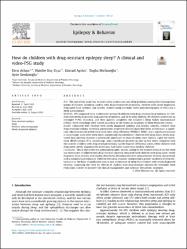| dc.contributor.author | Arhan, Ebru | |
| dc.contributor.author | Koç Uçar, Habibe | |
| dc.contributor.author | Aydın, Kürşad | |
| dc.contributor.author | Lüleci Hirfanoǧlu, Tuǧba | |
| dc.contributor.author | Serdaroğlu, Ayşe | |
| dc.date.accessioned | 2021-02-11T06:50:49Z | |
| dc.date.available | 2021-02-11T06:50:49Z | |
| dc.date.issued | 2021 | en_US |
| dc.identifier.citation | Arhan, E., Koç Uçar, H., Aydın, K., Lüleci Hirfanoǧlu, T. ve Serdaroğlu, A. (2021). How do children with drug-resistant epilepsy sleep? A clinical and video-PSG study. Epilepsy and Behavior, 114. https://dx.doi.org/10.1016/j.yebeh.2020.107320 | en_US |
| dc.identifier.issn | 1525-5050 | |
| dc.identifier.issn | 1525-5069 | |
| dc.identifier.uri | https://dx.doi.org/10.1016/j.yebeh.2020.107320 | |
| dc.identifier.uri | https://hdl.handle.net/20.500.12511/6546 | |
| dc.description.abstract | Aim: The aim of this study was to assess sleep architecture and sleep problems among three homogenous groups of children including children with drug-resistant focal epilepsy, children with newly diagnosed, drug-naive focal epilepsy, and healthy children using overnight video-polysomnography (V-PSG) and a sleep questionnaire.Methods: We compared sleep architecture among 44 children with drug-resistant focal epilepsy, 41 children with newly diagnosed, drug naive focal epilepsy, and 36 healthy children. All children underwent an overnight V-PSG recording, and their parents completed the Children's Sleep Habits Questionnaire (CSHQ). Sleep recordings were scored according to the American Academy of Sleep Medicine criteria.Results: Compared with children with newly diagnosed epilepsy and healthy controls, children with drug-resistant epilepsy receiving antiepileptic treatment showed disturbed sleep architecture, a significant reduction in time in bed, total sleep time, sleep efficiency, NREM3%, REM%, and a significant increase in awakenings, wake after sleep onset, and periodic leg movement. Children with drug-naive, newly diagnosed focal epilepsy showed a statistically significant increase in sleep onset latency, rapid eye movement (REM) latency, N1%, awakenings, and a significant decrease in time in bed when compared with the controls. Children with drug-resistant epilepsy had the highest CSHQ total scores, while children with drug-naive, newly diagnosed focal epilepsy had higher scores than healthy children.Conclusion: This is one of the few polysomnographic studies adding to the limited research on the sleep macrostructure of children with drug-resistant epilepsy compared with children with drug-naive, newly diagnosed focal epilepsy and healthy children by obtaining objective measurements of sleep concurrently with a validated questionnaire. Children with drug-resistant epilepsy had a greater incidence of sleep disturbance on the basis of qualitative aspects and architecture of sleep than children with newly diagnosed epilepsy, suggesting the need for referral of children with drug-resistant epilepsy for overnight sleep evaluation in order to improve the clinical management and optimize therapeutic strategies. | en_US |
| dc.language.iso | eng | en_US |
| dc.publisher | Academic Press Inc Elsevier Science | en_US |
| dc.rights | info:eu-repo/semantics/embargoedAccess | en_US |
| dc.subject | Drug-Resistant Epilepsy | en_US |
| dc.subject | Sleep | en_US |
| dc.subject | Pediatric Polysomnography | en_US |
| dc.subject | Newly Diagnosed Epilepsy | en_US |
| dc.title | How do children with drug-resistant epilepsy sleep? A clinical and video-PSG study | en_US |
| dc.type | article | en_US |
| dc.relation.ispartof | Epilepsy and Behavior | en_US |
| dc.department | İstanbul Medipol Üniversitesi, Tıp Fakültesi, Dahili Tıp Bilimleri Bölümü, Çocuk Sağlığı ve Hastalıkları Ana Bilim Dalı | en_US |
| dc.authorid | 0000-0003-1513-6149 | en_US |
| dc.identifier.volume | 114 | en_US |
| dc.relation.publicationcategory | Makale - Uluslararası Hakemli Dergi - Kurum Öğretim Elemanı | en_US |
| dc.identifier.doi | 10.1016/j.yebeh.2020.107320 | en_US |
| dc.identifier.wosquality | Q2 | en_US |
| dc.identifier.scopusquality | Q2 | en_US |


















